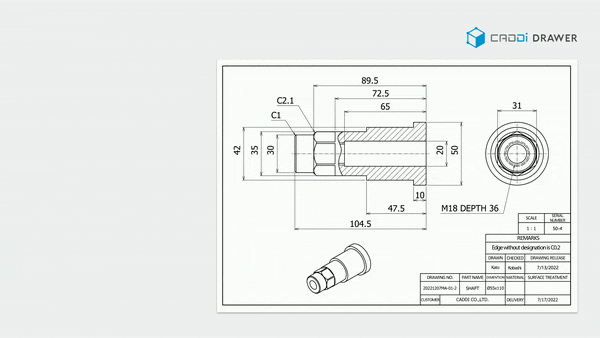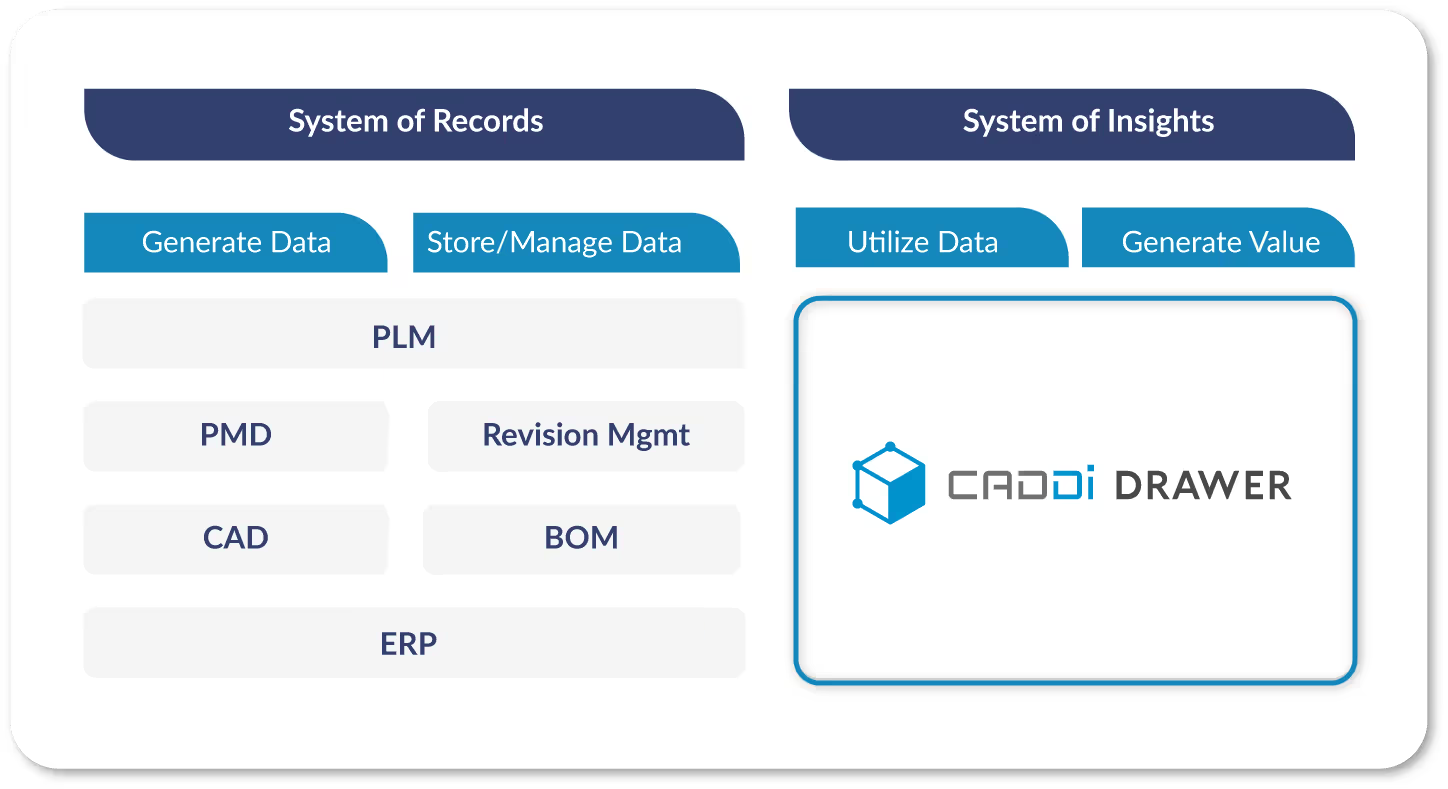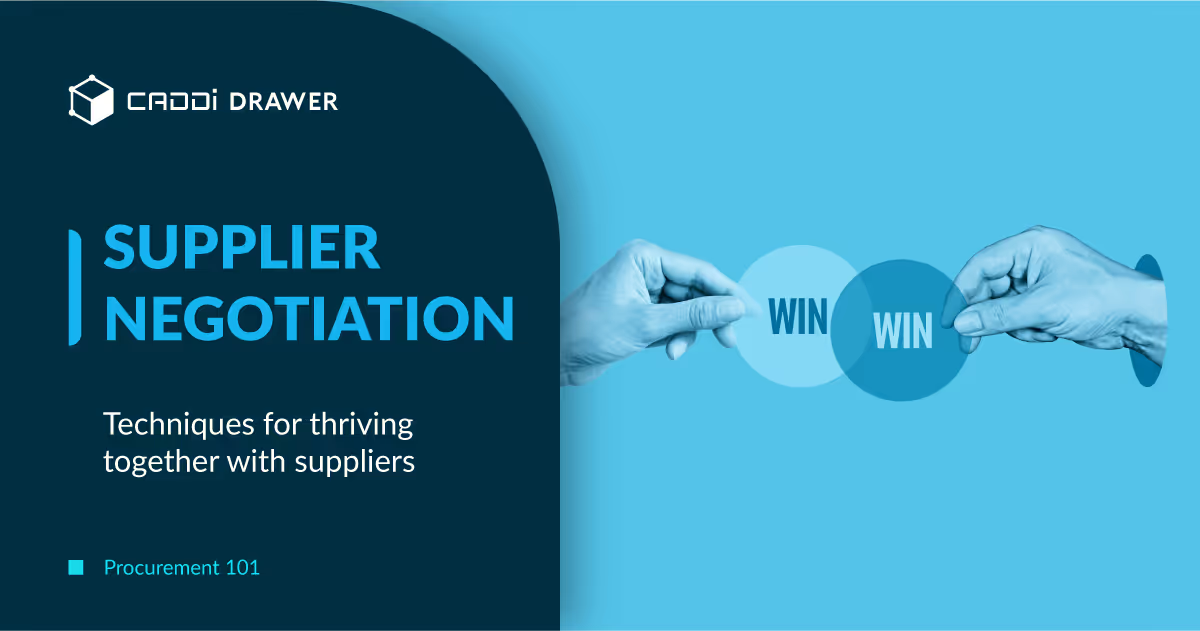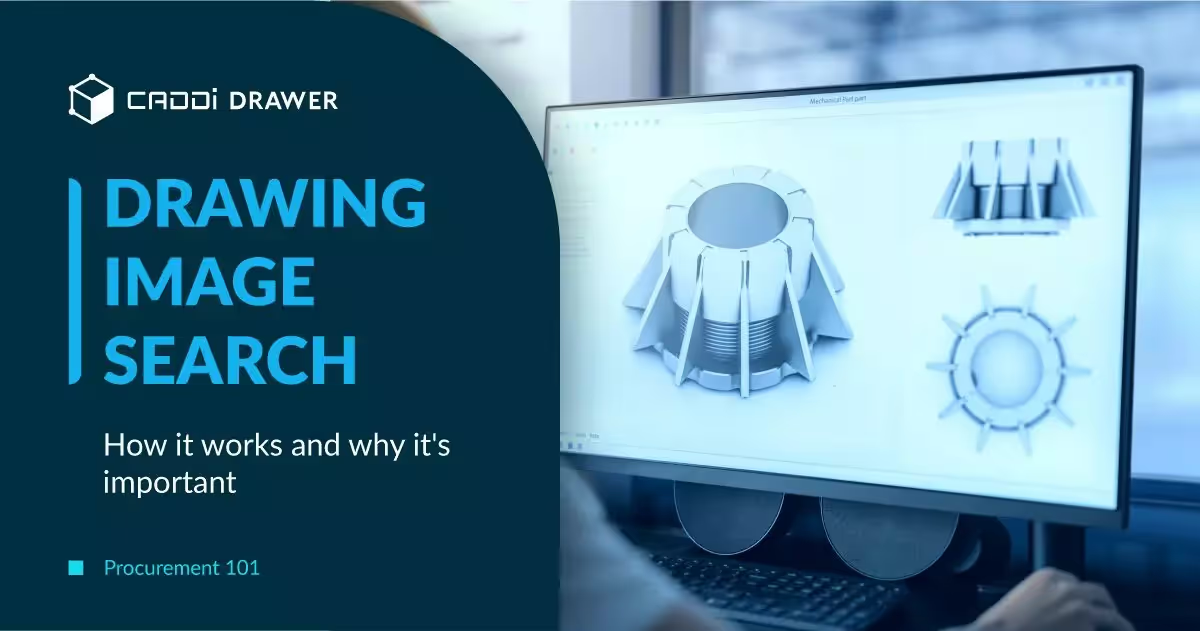Procurement 101: Supplier Management – What it is & how to execute it

Table of Contents

It’s clear that effective supplier management is not just about selecting the right suppliers but also about continuously managing and evaluating them to meet changing business needs and ensure sustainable supply chain operations. The strategic importance of these processes underlines the necessity for procurement departments to adopt structured, informed, and adaptable approaches to supplier management.
Why supplier management is crucial
Supplier management is imperative for procurement departments to ensure the stable supply of quality products. The practice involves evaluating suppliers based on their ability to meet the buyer company’s requirements, including product specifications and quality standards. This process is critical as it helps distinguish and manage suppliers effectively, ensuring they can continually meet these demands.
We’d like to emphasize the need for a structured approach to supplier management, which involves assessing suppliers based on predefined criteria, supporting their ability to deliver as required, and maintaining a mechanism that ensures consistent output despite environmental changes.
However, purchasing conditions, such as product specifications and quality standards, vary from company to company. Consequently, the specifics of managing suppliers differ in practice too. In supplier management, it’s essential to aseess suppliers based on your company’s unique criteria.
Methods for gathering information about suppliers
Accurate information gathering is the foundation of effective supplier management. This entails collecting basic information from suppliers, including:
- Company websites
- Product brochures
- Registration documents
- Financial statements
- Certifications
Buyer companies must gather more detailed information from suppliers through designated supplier questionnaire forms for suppliers to understand:
- Manufacturing capabilitiesProportion of products manufactured and industries servedProduction breakdown by material and component typeLimits on quantity, size, and thickness that can be accommodated, etc.
- Equipment
- Production capacity
- Staffing structure and organization charts
Obtaining data on supplier performance, such as defect rates and on-time delivery rates, is essential for ongoing management and improvement efforts. Additionally, it is also essential to identify key personnel within the supplier who have influence over decision-making through daily interactions.
Utilizing supplier information through assessment
Once information is gathered, it must be used to assess suppliers against consistent criteria. This assessment helps in making informed decisions about supplier selection and management.
The criteria for assessment include quality performance, cost performance, and on-time delivery performance, alongside the supplier’s management capabilities to maintain these standards. Transparent and objective assessment criteria are must-haves to avoid biased assessments and ensure that evaluations are grounded in factual and comparable data.
The evaluation criteria should be revisited and adjusted based on strategic business needs and external factors, such as market changes or shifts in management focus, to align supplier management practices with overall business objectives.
Utilizing supplier assessment results to inform purchasing policies
Procurement departments leverage outcomes from supplier assessment as foundational data for shaping purchasing policies. By quantifying these evaluations, companies can discern supplier tendencies and characteristics, aiding in the formulation of purchasing strategies that exploit suppliers’ strengths.
This method involves categorizing suppliers into similar groups for comparison, often visualized through radar charts to facilitate decision-making.
It is also often observed in the industry that the assessment of suppliers is thoroughly conducted only at the time of initial registration, and subsequent evaluations tend to be neglected.
However, conducting regular assessments at the same level as the initial one is essential to fully grasp both positive and negative changes, such as the expansion of the supplier’s capabilities or the departure of key personnel. It ensures that decisions regarding orders or strategic directions are based on up-to-date assessments, underscoring the importance of integrating evaluation results into the broader purchasing framework.
Differentiating suppliers for targeted management
Upon assessing suppliers, they should be categorized based on the nature of purchased goods, enabling procurement departments to tailor their approach for each category.
Indispensable Suppliers for Current Business Operations: These are suppliers who account for a significant portion of total purchases. They are not just suppliers; they are integral partners in our journey, ensuring the wheels of our operations keep turning smoothly.
Suppliers Essential for Future Business Operations: Not judged merely on current purchasing volume, these suppliers are vital for their potential in collaborative development and prototype orders leveraging technologies needed for the future. They stand out not only for the products they supply but also for the technological support they provide, making them key players in our journey towards innovation and growth.
Suppliers Without Alternative Sources: These are suppliers for whom, at the time of evaluation, no alternative purchasing sources exist within the buying company. A halt in their supply could pose existential threats to the buyer’s business. At the same time, these suppliers are challenging to influence due to their unique position, making them critical yet delicate links in our supply chain.
Suppliers meeting any of these criteria are deemed crucial and are managed with a focus on fostering long-term, strategic partnerships. This nuanced categorization allows for more focused and effective supplier relationships, ensuring that procurement efforts align closely with the company’s strategic needs and risk management practices.
Tailored approaches to supplier management
The management of suppliers varies significantly across different categories.
For indispensable suppliers, the approach is collaborative, sharing both short-term and long-term outlooks to secure prioritized treatment. It is essential to clearly communicate to them their status as key suppliers and to tighten the communication between the top executives of both the procurement and purchasing departments and the suppliers’ sales departments to ensure the exchange of intentions. Information provision from the procurement side should be conducted in a manner and with content that distinguishes it from that of general suppliers, aiming to build a strategic relationship. Organizing exclusive supplier meetings could also be an effective strategy.
It’s common practice to rank suppliers primarily based on the magnitude of past purchases as described above. However, a supplier who was important in the past may not necessarily remain ‘important’ in the future. Instead, continuous management efforts are required on the procurement side to ensure this importance persists. It’s essential to consider actual performance and future needs, provide feedback to suppliers, and foster a sense of urgency. This approach is crucial for maintaining a dynamic and resilient supply chain that adapts to changing business landscapes.
In contrast, general suppliers, not distinguished as critical, receive standard communication about procurement needs without the strategic engagement reserved for key suppliers. However, even among general suppliers, vigilance is necessary to identify potential future key suppliers, highlighting the dynamic nature of supplier relationships and the importance of adaptability in procurement strategies.
Managing supplier capabilities
Effective supplier management requires a deep understanding of the supplier’s capabilities in relation to the buyer’s needs. This involves identifying gaps between what the supplier can offer and what the buyer requires, and deciding whether to improve the existing supplier’s performance or to seek alternatives.
The core areas for management include quality, cost, delivery, development capabilities, and loyalty. Regular audits are conducted to ensure that suppliers maintain their capabilities over time.
When deficiencies are identified, procurement departments must communicate these issues clearly, setting out specific expectations for improvement, and considering whether to provide guidance for improvement or to look for alternative suppliers.
Exploring new suppliers
When evaluations indicate that a supplier’s improvement is unlikely, the search for new suppliers begins. This process involves a thorough analysis of why the current supplier relationship failed to meet expectations, focusing on identifying and rectifying the root causes of mismatches.
The search for a new supplier involves a comprehensive reassessment of potential suppliers’ capabilities to ensure they can meet the buyer’s requirements without repeating past mistakes. This approach underscores the importance of agility and proactive risk management in procurement strategies, emphasizing the need for a clear understanding of both the buyer’s requirements and the supplier’s ability to meet those needs.
Maintaining good supplier relationships
The foundation for building and sustaining good relationships with suppliers is based on mutual understanding and agreement between buyer companies and suppliers. The key to maintaining these relationships lies in small, consistent acts of trust. This includes ensuring that agreements, beyond contractual obligations, are upheld and openly communicating any challenges that might prevent fulfilling these promises.
A good relationship is not just about stable interactions but also about improving quality, delivery times, and costs. It requires a continuous effort to monitor and manage the relationship dynamically, ensuring that both parties strive towards maximizing mutual benefits.
Hosting supplier meetings with a purpose
The evolution of supplier meetings from a mere formality to a strategic necessity underscores the changing dynamics in procurement. The focus has shifted towards making these meetings meaningful by sharing future business prospects, technological roadmaps, and strategic insights that can aid suppliers in aligning their plans with those of the buyer company.
The role of procurement in these meetings is to facilitate discussions, ensuring that communication goes beyond the routine demands for cost reductions and quality improvements to include valuable information that can foster long-term collaborations.
Strategic supplier development and disengagement
The articles highlight the strategic importance of developing new suppliers when current ones cannot meet the evolving needs of the business and how to gracefully disengage from relationships that no longer serve mutual interests. This involves a careful analysis of supplier capabilities, identifying areas for improvement, and exploring new market opportunities to meet procurement needs. The process is delicate and requires a balanced approach to ensure that transitions are smooth and do not adversely affect the supply chain.
How CADDi Drawer can help managing supplier capabilities
As mentioned above, the utilization of data is indispensable in supplier management. Therefore, not only is the collection of data crucial, but it is also important that this data is in a manageable state. This has become a challenging issue for many companies in the manufacturing industry.
The most understandable and critical case is when various pieces of information contained in drawings, such as material specifications and footnotes, are not structured data, and even when they are data, the information is scattered across different items or not easily searchable.
To solve this challenge, various tools have been developed, one of which is CADDi Drawer. CADDi Drawer:
- Extracts and structures information contained within a vast number of drawings held company-wide.
- It can then link these data with procurement data, supplier data, and specifications stored in systems like ERP or spreadsheets, each associated with the respective drawings.
- With this data foundation established, it enables keyword searches, searches by tags attached to drawings, or searches for drawings of similar parts based on the similarity of part shapes.

In supplier management, by linking past purchase price information with supplier performance and the results of supplier assessments, the process can be streamlined. This allows the procurement department to allocate more time to more essential activities, such as building strategic relationships with suppliers and gaining a deeper understanding of supplier capabilities.

It’s clear that effective supplier management is not just about selecting the right suppliers but also about continuously managing and evaluating them to meet changing business needs and ensure sustainable supply chain operations. The strategic importance of these processes underlines the necessity for procurement departments to adopt structured, informed, and adaptable approaches to supplier management.
Why supplier management is crucial
Supplier management is imperative for procurement departments to ensure the stable supply of quality products. The practice involves evaluating suppliers based on their ability to meet the buyer company’s requirements, including product specifications and quality standards. This process is critical as it helps distinguish and manage suppliers effectively, ensuring they can continually meet these demands.
We’d like to emphasize the need for a structured approach to supplier management, which involves assessing suppliers based on predefined criteria, supporting their ability to deliver as required, and maintaining a mechanism that ensures consistent output despite environmental changes.
However, purchasing conditions, such as product specifications and quality standards, vary from company to company. Consequently, the specifics of managing suppliers differ in practice too. In supplier management, it’s essential to aseess suppliers based on your company’s unique criteria.
Methods for gathering information about suppliers
Accurate information gathering is the foundation of effective supplier management. This entails collecting basic information from suppliers, including:
- Company websites
- Product brochures
- Registration documents
- Financial statements
- Certifications
Buyer companies must gather more detailed information from suppliers through designated supplier questionnaire forms for suppliers to understand:
- Manufacturing capabilitiesProportion of products manufactured and industries servedProduction breakdown by material and component typeLimits on quantity, size, and thickness that can be accommodated, etc.
- Equipment
- Production capacity
- Staffing structure and organization charts
Obtaining data on supplier performance, such as defect rates and on-time delivery rates, is essential for ongoing management and improvement efforts. Additionally, it is also essential to identify key personnel within the supplier who have influence over decision-making through daily interactions.
Utilizing supplier information through assessment
Once information is gathered, it must be used to assess suppliers against consistent criteria. This assessment helps in making informed decisions about supplier selection and management.
The criteria for assessment include quality performance, cost performance, and on-time delivery performance, alongside the supplier’s management capabilities to maintain these standards. Transparent and objective assessment criteria are must-haves to avoid biased assessments and ensure that evaluations are grounded in factual and comparable data.
The evaluation criteria should be revisited and adjusted based on strategic business needs and external factors, such as market changes or shifts in management focus, to align supplier management practices with overall business objectives.
Utilizing supplier assessment results to inform purchasing policies
Procurement departments leverage outcomes from supplier assessment as foundational data for shaping purchasing policies. By quantifying these evaluations, companies can discern supplier tendencies and characteristics, aiding in the formulation of purchasing strategies that exploit suppliers’ strengths.
This method involves categorizing suppliers into similar groups for comparison, often visualized through radar charts to facilitate decision-making.
It is also often observed in the industry that the assessment of suppliers is thoroughly conducted only at the time of initial registration, and subsequent evaluations tend to be neglected.
However, conducting regular assessments at the same level as the initial one is essential to fully grasp both positive and negative changes, such as the expansion of the supplier’s capabilities or the departure of key personnel. It ensures that decisions regarding orders or strategic directions are based on up-to-date assessments, underscoring the importance of integrating evaluation results into the broader purchasing framework.
Differentiating suppliers for targeted management
Upon assessing suppliers, they should be categorized based on the nature of purchased goods, enabling procurement departments to tailor their approach for each category.
Indispensable Suppliers for Current Business Operations: These are suppliers who account for a significant portion of total purchases. They are not just suppliers; they are integral partners in our journey, ensuring the wheels of our operations keep turning smoothly.
Suppliers Essential for Future Business Operations: Not judged merely on current purchasing volume, these suppliers are vital for their potential in collaborative development and prototype orders leveraging technologies needed for the future. They stand out not only for the products they supply but also for the technological support they provide, making them key players in our journey towards innovation and growth.
Suppliers Without Alternative Sources: These are suppliers for whom, at the time of evaluation, no alternative purchasing sources exist within the buying company. A halt in their supply could pose existential threats to the buyer’s business. At the same time, these suppliers are challenging to influence due to their unique position, making them critical yet delicate links in our supply chain.
Suppliers meeting any of these criteria are deemed crucial and are managed with a focus on fostering long-term, strategic partnerships. This nuanced categorization allows for more focused and effective supplier relationships, ensuring that procurement efforts align closely with the company’s strategic needs and risk management practices.
Tailored approaches to supplier management
The management of suppliers varies significantly across different categories.
For indispensable suppliers, the approach is collaborative, sharing both short-term and long-term outlooks to secure prioritized treatment. It is essential to clearly communicate to them their status as key suppliers and to tighten the communication between the top executives of both the procurement and purchasing departments and the suppliers’ sales departments to ensure the exchange of intentions. Information provision from the procurement side should be conducted in a manner and with content that distinguishes it from that of general suppliers, aiming to build a strategic relationship. Organizing exclusive supplier meetings could also be an effective strategy.
It’s common practice to rank suppliers primarily based on the magnitude of past purchases as described above. However, a supplier who was important in the past may not necessarily remain ‘important’ in the future. Instead, continuous management efforts are required on the procurement side to ensure this importance persists. It’s essential to consider actual performance and future needs, provide feedback to suppliers, and foster a sense of urgency. This approach is crucial for maintaining a dynamic and resilient supply chain that adapts to changing business landscapes.
In contrast, general suppliers, not distinguished as critical, receive standard communication about procurement needs without the strategic engagement reserved for key suppliers. However, even among general suppliers, vigilance is necessary to identify potential future key suppliers, highlighting the dynamic nature of supplier relationships and the importance of adaptability in procurement strategies.
Managing supplier capabilities
Effective supplier management requires a deep understanding of the supplier’s capabilities in relation to the buyer’s needs. This involves identifying gaps between what the supplier can offer and what the buyer requires, and deciding whether to improve the existing supplier’s performance or to seek alternatives.
The core areas for management include quality, cost, delivery, development capabilities, and loyalty. Regular audits are conducted to ensure that suppliers maintain their capabilities over time.
When deficiencies are identified, procurement departments must communicate these issues clearly, setting out specific expectations for improvement, and considering whether to provide guidance for improvement or to look for alternative suppliers.
Exploring new suppliers
When evaluations indicate that a supplier’s improvement is unlikely, the search for new suppliers begins. This process involves a thorough analysis of why the current supplier relationship failed to meet expectations, focusing on identifying and rectifying the root causes of mismatches.
The search for a new supplier involves a comprehensive reassessment of potential suppliers’ capabilities to ensure they can meet the buyer’s requirements without repeating past mistakes. This approach underscores the importance of agility and proactive risk management in procurement strategies, emphasizing the need for a clear understanding of both the buyer’s requirements and the supplier’s ability to meet those needs.
Maintaining good supplier relationships
The foundation for building and sustaining good relationships with suppliers is based on mutual understanding and agreement between buyer companies and suppliers. The key to maintaining these relationships lies in small, consistent acts of trust. This includes ensuring that agreements, beyond contractual obligations, are upheld and openly communicating any challenges that might prevent fulfilling these promises.
A good relationship is not just about stable interactions but also about improving quality, delivery times, and costs. It requires a continuous effort to monitor and manage the relationship dynamically, ensuring that both parties strive towards maximizing mutual benefits.
Hosting supplier meetings with a purpose
The evolution of supplier meetings from a mere formality to a strategic necessity underscores the changing dynamics in procurement. The focus has shifted towards making these meetings meaningful by sharing future business prospects, technological roadmaps, and strategic insights that can aid suppliers in aligning their plans with those of the buyer company.
The role of procurement in these meetings is to facilitate discussions, ensuring that communication goes beyond the routine demands for cost reductions and quality improvements to include valuable information that can foster long-term collaborations.
Strategic supplier development and disengagement
The articles highlight the strategic importance of developing new suppliers when current ones cannot meet the evolving needs of the business and how to gracefully disengage from relationships that no longer serve mutual interests. This involves a careful analysis of supplier capabilities, identifying areas for improvement, and exploring new market opportunities to meet procurement needs. The process is delicate and requires a balanced approach to ensure that transitions are smooth and do not adversely affect the supply chain.
How CADDi Drawer can help managing supplier capabilities
As mentioned above, the utilization of data is indispensable in supplier management. Therefore, not only is the collection of data crucial, but it is also important that this data is in a manageable state. This has become a challenging issue for many companies in the manufacturing industry.
The most understandable and critical case is when various pieces of information contained in drawings, such as material specifications and footnotes, are not structured data, and even when they are data, the information is scattered across different items or not easily searchable.
To solve this challenge, various tools have been developed, one of which is CADDi Drawer. CADDi Drawer:
- Extracts and structures information contained within a vast number of drawings held company-wide.
- It can then link these data with procurement data, supplier data, and specifications stored in systems like ERP or spreadsheets, each associated with the respective drawings.
- With this data foundation established, it enables keyword searches, searches by tags attached to drawings, or searches for drawings of similar parts based on the similarity of part shapes.

In supplier management, by linking past purchase price information with supplier performance and the results of supplier assessments, the process can be streamlined. This allows the procurement department to allocate more time to more essential activities, such as building strategic relationships with suppliers and gaining a deeper understanding of supplier capabilities.

Ready to see CADDi Drawer in action? Get a personalized demo.
Subscribe to our Blog!
Related Resources












.svg)



.svg)
.svg)
.svg)


